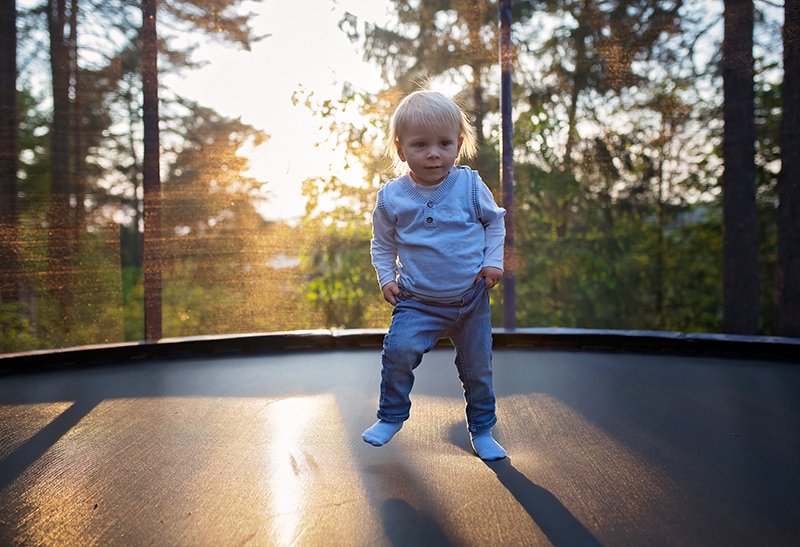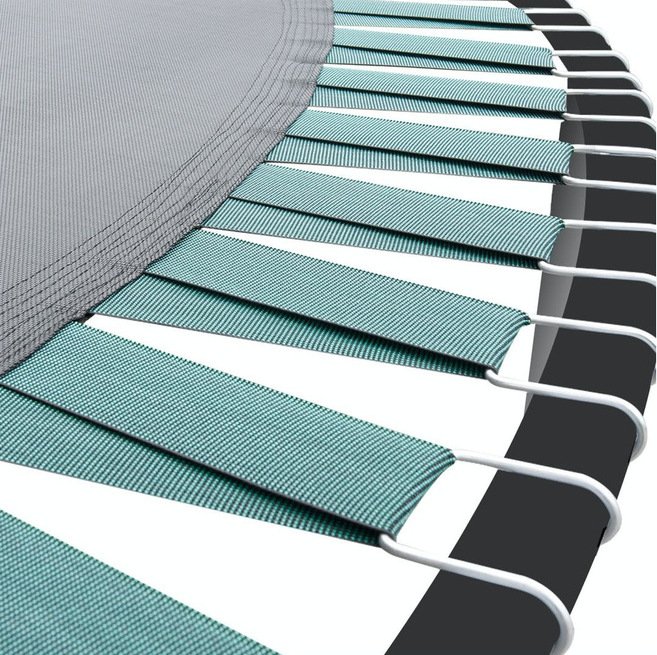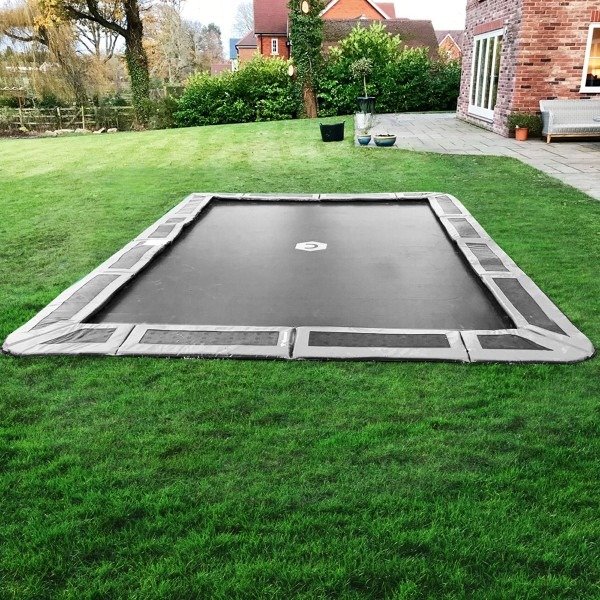If you are looking for a way to hit two birds with one stone, then you need to consider a kid’s trampoline. It’s a great way to entertain your little ones while providing them with the opportunity to exercise. It might not seem like it, but there is a difference between a kid’s trampoline and a regular one. A kid’s trampoline is smaller, has more safety features and versatility options than a standard trampoline.

Skywalker Kids Trampoline
The Skywalker Trampoline makes the ideal gift for a junior family member. While your child is jumping, there is a series of space sounds run by 3 AA batteries that sync in with their jumps.
Best Overall
The Skywalker Trampoline is our favorite for several reasons. The safety net is sewn directly into the jumping mat to guarantee your child will not slip through the cracks. It is space-themed galore! There are stars and a moon on the mat, And space sounds that synchronize with your child jumping. It’s the perfect trampoline for indoor use or apartment living, as it does not require an extensive amount of space.
Best Kids Trampoline
With your older kids, they require more than what a toddler’s trampoline could offer. The Ativafit is perfect for any child who just loves to bounce! The Ativafit is very easy to set up and put away. You can simply fold it up when you’re not using it and store it away in a cupboard. It takes up less space than other trampolines would without compromising on the fun. The safety features on this trampoline are incredible and will ease any parent’s mind.
Best Toddler Trampoline
Toddlers require more safety features than the average child. To ensure that a toddler’s safety comes first, we’ve picked the 60” trampoline by Aseem. It has 3 U-shaped legs with large suction cups on the bottom of the legs for added stability. There’s a large safety net that will prevent your toddler from falling off the side. Aseem has created the trampoline with toddlers in mind; everything from the size to materials used is safe to expose to your toddlers.
Best Trampoline for Your Kids Childhood
If you’re looking at long-term fun, then the Aseem 60″ Kids Trampoline is ideal. They created it with growing children in mind. It is the perfect trampoline for your child to grow up with and use for their entire childhood. There’s a safety net all around the trampoline. You’ll find three U-shaped legs for all-around support and safety. The zipper door makes sure your kid can’t escape in the blink of an eye!
Best Trampoline that Doubles as an Exercise Trampoline
If you are looking for a trampoline that you could incorporate into your exercise routine, have a look at the SereneLife Kids Trampoline. It is an easily portable exercise trampoline with elastic springs. It is a great cardio partner to get your heart rate going.
Safety Tips for Trampolines
A trampoline could have a thousand protective measures, but it still requires specific actions to be taken. Accidents are always a possibility when owning a trampoline. However, taking these extra measures keeps injuries to a minimum. When using a trampoline, make sure you’re keeping these safety tips in mind!
Features to Keep in Mind When Considering a Trampoline for Your Child
Kids and toddlers are at significantly different stages of development. So requirements for a kids trampoline and a toddler’s trampoline will vary as well. Here are our criteria for selecting toddlers and kids trampoline that is the most suitable for your child.
Toddlers Trampoline (1 to 5 Years)
- Enclosed Trampolines
Almost all the trampolines on the list come with a safety net. But because toddlers are still wobbly on their feet, the netting ensures that your kid can have fun without bouncing so high that they fall off the trampoline. When connected properly, there’s very little chance of it coming loose. The net allows you to monitor your tiny kiddos while having safe fun.
- Multifunctional Potential
Our definition of a multifunctional toy is that it has multiple uses. The multifunctional kids trampolines on this list come with added accessories, such as a swing, ball pit, a small basketball hoop, and plastic balls. It provides the child with more ways to have stimulating fun and more ways to save money.


Kids Trampoline (6 to 12 Years)
- Removable and Adjustable Handlebars
As our energetic children grow, they develop an interest in trying new and riskier things. Therefore, we believe trampolines should come with removable and adjustable handlebars. The removable aspect is important because your children are constantly developing their skills and growing. They will reach a point where they no longer need the extra support. But it is an important feature for a developing child who is new to jumping on a trampoline.
The adjustable aspect is helpful for those pesky growth spurts. You don’t want to replace your trampoline as you do with your child’s clothes. Trampolines are not as easy to replace, so purchasing one that will last for a few years is the ideal way to go. The best way to ensure this is to find a kids trampoline with an adjustable handlebar that can grow with your child.
Benefits of Trampolines for Your Kids
Believe it or not, mini trampolines are more than just a way for a kid to hop and jump! From digital cleanse to physical fitness, they can do a lot for your kiddos’ development.
Our list will pinpoint some of the amazing ways in which your kids can benefit from regular trampolining.
Leisurely Stress-Relief Activity
After they have finished their homework, are your kids spending a lot of time in front of screens playing games or watching TV? This does not help their brain and body truly destress. So what’s the solution?
Jumping on a trampoline is the perfect solution. It requires little concentration as your kids move around, which helps reduce their stress levels as they find something else to focus on other than studies. Physical exercise helps the body to release the feel-good hormones, endorphins, that boost your mood. And they’ll get a good night’s sleep.
Trampolining is a no-brainer. It is a simple bounce exercise that requires no training, rules, or time restrictions. So the simplicity of this activity is why kids can enjoy it.
Improves Motor Skills
Jumping on a trampoline develops and improves your child’s gross motor skills because there is a constant change in the center of gravity.
In the beginning, they will struggle to maintain their balance the first few jumps, but don’t worry. They’ll get the hang of it. During this process, they learn to control the movements of multiple muscles simultaneously and constantly. This balance, agility, and rhythm between mind and body assist in developing new motor skills.
Gives Kids Toned Muscles And A Better Posture
There is a list of physical benefits of jumping on a trampoline. It works with almost every muscle in your body, encouraging good musculature and core strength. When working your muscles, your need for oxygen increases, leading to a sped-up heart rate and breathing, promoting good heart and lung function.
To remain balanced in the air, the muscles around your spine and joints are put to work, which results in them being strengthened and improving your posture. Staying balanced requires developing your motor skills, which encourages the development of the child’s nervous system. Your brain is a part of your nervous system, and with its promoted development, your concentration and learning capabilities will improve. Jumping a trampoline increases your appetite, which supports your gastrointestinal digestion.
If you place your kid’s trampoline outdoors, the exposure to sunlight increases the Vitamin D levels needed for good bone structure and immune system! In the future, this will prevent health issues like osteoporosis and keep your kiddos healthy.
Early Development Of Sensory System
Trampolines provide a focused exercise that targets your brain. It gives repeated stimulation of the vestibular system. This system gets activated through the fast movements of jumping on a trampoline.
The vestibular system coordinates all the information coming from the peripheral nervous system and controls our movements accordingly. The vestibular system governs your kids’ auditory and visual functions. So trampolining can aid the development of vision, hearing, auditory-motor, and visual-motor skills.
Higher Degree Of Learning Abilities
We know how important academics are in a kid’s life. Several areas of development are being worked on while jumping on a trampoline that plays a pivotal role in improving your child’s academic success. For example, developing motor skills in your child results in better academic results due to increased concentration spans.
The neural networks used during motor skill development are the same neural networks used by the brain. In simple words, when you exercise your body, you are exercising your mind as well, specifically for learning and memory!
Types of Trampolines
Finding the right trampoline for your child means considering a few factors, such as size, shame, indoor or outdoor, the kind of springs used, and so forth.
Let’s look at some of the most common types and shapes of mini-trampolines.
Indoor vs Outdoor Trampolines
The crucial difference between indoor and outdoor trampolines is that outdoor trampolines are made to last in the sun. Unlike indoor trampolines, they are made with UV-protected fabrics throughout their design to withstand the damaging sun rays. Although, the kids’ trampoline is small enough to fit anywhere. So parents can use an outdoor trampoline inside. However, manufacturers do not recommend using an indoor trampoline outdoors.
Spring-Based vs Springless Trampolines
The spring-based trampolines are the traditional kids’ trampoline that you will see most often. These are the trampolines that have a stainless steel spring connecting the jumping mat to the trampoline frame. A padded or non-padded protection cover usually covers the springs. Spring-based trampolines are more for children who have had trampolining experience.
Because of the high bounce of the springs, it is natural for parents to worry about their kids getting too hyperactive on trampolines. The market is now coming up with a safer alternative for that with springless trampolines.
Instead of using springs, manufacturers use alternative materials to create the same level of bounce. They made most springless trampolines with some type of stretch band, like a bungee elastic band. Your kid can enjoy trampolining to the fullest without the danger of springing up too high and injuring themselves. Parents tend to use springless trampolines for younger kids and toddlers.


Shape of Trampoline
Round Trampoline
This is the most common shape used in the design of a toddler or kid’s trampoline. The circular spring design directs the children to stay in the center of the mat, lowering the risk of them falling off the trampoline and getting injured.
Rectangular Trampoline
The rectangular design is easy for maneuvering. Rectangular trampolines also come with what manufacturers call the “sweet spot.” Older kids use this kind of trampoline because it allows kids to perform tricks safely because of the sweet spot and trampoline shape.
Square Trampoline
Square trampolines provide the best of both round and rectangular trampolines. They replicate the extra safe jump of a round trampoline with the bounce quality and trick ability of a rectangular one. Now that’s what we call an all-rounder.
Oval Trampoline
The oval trampoline has the benefits of both the rectangular and circular trampoline. Unlike the round trampoline, the oval trampoline provides a larger jumping area with more bounce around the entire jumping surface.




Frequently Asked Questions (FAQs)
Where do I place a kid’s trampoline?
To avoid accidents, ensure there is a lot of space around and above your kid’s trampoline. You should set it up on a leveled ground to ensure no unneeded strain is placed on the trampoline’s frame; this will ensure its lifespan and your child’s safety because it will be less likely to fall over.
How long do mini trampolines for kids and toddlers last?
The life cycle of a kid’s trampoline varies from manufacturer to manufacturer. However, you don’t need to worry about replacing it soon because most reputable trampoline brands design them to last anywhere from 3 to 8 years.
How long should your kids bounce on the trampoline?
You can let your kids jump for 10-30 minutes every day. We suggest letting kids bounce for 10 minutes. Even in just 10 minutes, the low-impact exercise for your kids can increase their heart rate to the optimal level for maintaining a healthy cardiovascular system. Make sure the kids are not pushing themselves too hard. Long bouncing periods with no breaks can put stress on their muscles and joints.
Can trampolines be dangerous?
It can be dangerous in terms of causing injuries. But there are ways to minimize and prevent the risk. If you are concerned about the larger trampolines, consider mini-trampolines. Mini trampolines have less bounce than the larger trampolines, meaning there isn’t enough bounce and space for your child to attempt tricks. And the rounded edges mean they are less likely to fall and hit sharp edges.
Endnotes
With trampolines for your kids, you can’t buy anything, but what you feel is the best for your child and their safety. And now that you have all the tips and tricks, you can make an informed and confident decision about which trampoline to buy. Remember to pay close attention to your kids’ needs and skill level before deciding which trampoline to purchase.